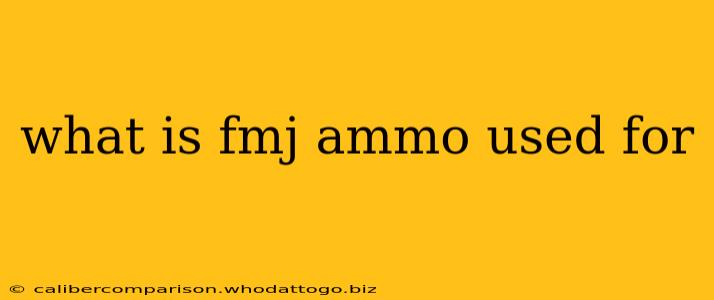Full Metal Jacket (FMJ) ammunition is a common type of bullet used in various firearms, from handguns to rifles. Understanding its purpose and applications requires exploring its construction, ballistics, and legal considerations. This guide delves into the specifics of FMJ ammo, clarifying its uses and dispelling common misconceptions.
Understanding FMJ Ammo Construction
FMJ ammo gets its name from its construction: a lead core encased in a metal jacket, typically copper-plated or gilding metal. This jacket fully encases the projectile, unlike other bullet types like hollow points or soft points, which have exposed lead. This complete metal encasement is the key differentiator affecting its performance and applications.
Key Characteristics of FMJ Ammo:
- Penetration: The full metal jacket contributes to higher penetration compared to other bullet types. The lead core maintains its integrity upon impact, resulting in a bullet that travels further through targets.
- Expansion: FMJ rounds generally do not expand significantly upon impact. This lack of expansion is a crucial factor in its intended uses.
- Ricochet: The hard metal jacket can increase the risk of ricochet, making it important to practice responsible firearm handling and target selection.
Common Uses of FMJ Ammo
FMJ ammo's characteristics make it suitable for several applications:
1. Target Practice and Training:
This is arguably the most prevalent use. The consistent performance and relatively lower cost of FMJ make it ideal for target shooting, sighting in rifles, and practicing shooting techniques. Its lack of expansion minimizes collateral damage on backstops.
2. Military and Law Enforcement Applications:
FMJ's high penetration is valued in scenarios demanding maximum range and target penetration. This type of round is often preferred for military rifles and some law enforcement applications where deep penetration is necessary. Note: The specific regulations surrounding the use of FMJ ammunition by law enforcement can vary significantly by jurisdiction.
3. Hunting (Specific Applications):
While not the first choice for many hunting situations, FMJ can be effective for certain hunting applications, such as varmint hunting (e.g., prairie dogs) at longer ranges where deep penetration is crucial to ensure a clean kill. However, many hunters prefer expanding rounds for ethical hunting practices, focusing on rapid incapacitation.
4. Competition Shooting:
Certain shooting competitions specifically mandate the use of FMJ ammunition due to its consistent performance and lack of expansion, ensuring a level playing field for competitors.
Legal Considerations and Restrictions
The legality of FMJ ammo varies depending on location. Some jurisdictions impose restrictions, particularly concerning its sale or use in certain calibers or for specific purposes. It is crucial to understand and abide by all local, state, and federal laws and regulations concerning ammunition possession and usage.
FMJ Ammo vs. Other Ammunition Types
Understanding how FMJ ammunition differs from other types of bullets is critical. Comparing it to hollow-point (HP) or soft-point (SP) ammunition highlights the key distinctions:
| Feature | FMJ | Hollow Point (HP) | Soft Point (SP) |
|---|---|---|---|
| Jacket | Full Metal Jacket | Partial Metal Jacket | Partial Metal Jacket |
| Expansion | Minimal | Significant | Moderate |
| Penetration | High | Moderate | Moderate to High |
| Intended Use | Target practice, Military | Self-defense, Hunting | Hunting, Self-defense |
Conclusion
FMJ ammo's design dictates its application. Its consistent performance and high penetration make it suitable for target practice, military applications, and specific hunting scenarios. However, awareness of its limitations, including potential for ricochet and lack of expansion, is vital for responsible handling and ethical use. Always prioritize safety and compliance with all relevant regulations when using any type of ammunition. Consult local authorities and firearm experts for clarification on legal restrictions in your area.

